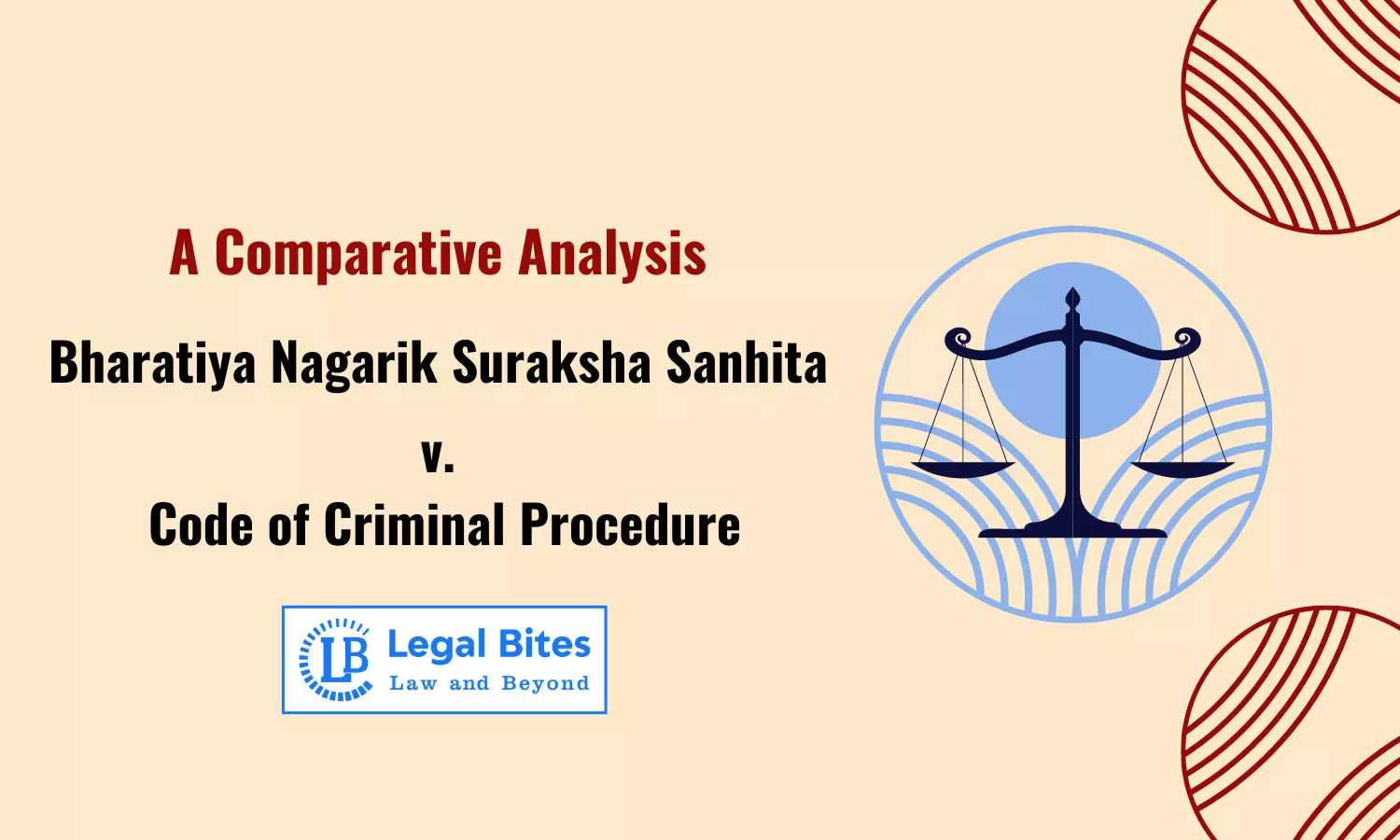A Comparative Analysis: Bharatiya Nagarik Suraksha Sanhita v. Code of Criminal Procedure
The article scrutinizes the replacement of CrPC provisions with those of the Bharatiya Nagarik Suraksha Sanhita and its implications.

The article scrutinizes the replacement of CrPC provisions with those of the Bharatiya Nagarik Suraksha Sanhita and its implications for modern legal practices.
Introduction
The Code of Criminal Procedure, 1973, governs the procedural aspect of the criminal justice system in the country. It tries to speed up the justice system by fixing issues like too many cases waiting to be heard, low conviction rates, inadequate technology being used in the legal system, long investigation procedures, and poor use of forensic techniques. The Bharatiya Nagarik Suraksha Sanhita of 2023 has replaced the 1973 Code of Criminal Procedure. Bhartiya Nagarik Suraksha Sanhita (BNSS) has amended the provisions of bail, seizure of property, powers of Magistrates and police authorities.
Highlights
- The BNSS mandates foreign investigations where foreign experts will be appointed to visit the crime scenes to collect evidence and record it. This investigation is for the offences punishable by seven years imprisonment or above.
- All trials, inquiries, and other procedures will be conducted electronically. Further digital evidence is admissible for investigation, trial, or other inquiries.
- If a proclaimed offender has absconded, then now, under the new Act, the trial can also be conducted, and the judgment can be given in his absence.
- Signs, finger impressions, and voice recording samples can be collected for trial or investigation.
Key Features
The following are some of the changes that the Act made:
i. Information to the Police and Their Investigative Powers
Information about the commission of a cognizable offence, regardless of the location where the offence occurs, can be conveyed either verbally or through electronic means to the designated officer at a police station.
ii. Procedures
To make the court system run more smoothly, the BNSS sets specific times for different legal procedures. The amendments are:
- Section 230 describes the accused and the victim must be given the necessary documents within 14 days of the accused production or appearance.
- According to Section 232, the Committal Proceedings must be finished within 90 days of the date of taking cognizance. The Magistrate can stretch this time limit by up to 180 days, but only if the reasons are recorded in writing.
- Section 250 says that the charged person has 60 days from the date of committal to file for discharge.
- As per Section 263, the accused person must be charged within 60 days of the date of the first hearing on the charge.
- Section 346 states that cases or inquiries can continue daily until all the witnesses have been questioned. However, each side can only ask for two adjournments in total.
- Section 258 says that a decision of guilty or innocent must be given within 30 days of the end of the arguments. If there are good reasons, this deadline can be pushed back to 45 days.
iii. Forensic Investigations
Section 176 of the BNSS requires forensic investigations for crimes with a minimum sentence of seven years in jail. In these situations, forensic experts must go to crime scenes to collect evidence and record the procedure using electronic devices. If a state doesn't have its forensic tools, it must find and use those in another state. Thus, these experts are in charge of both gathering evidence at crime scenes and recording it.
iv. Procedure when investigation cannot be completed in twenty-four hours
Whenever an individual is arrested and held in custody, and it becomes apparent that the investigation cannot be concluded within the twenty-four-hour period stipulated by section 58, and there exist reasonable grounds to believe in the validity of the accusation or information, the officer in charge of the police station or the investigating police officer, provided they are of at least the rank of sub-inspector, must promptly submit to the nearest Magistrate a copy of the entries recorded in the specified diary about the case. Simultaneously, they must arrange for the accused to be presented before the said Magistrate.
The Magistrate to whom an accused person is presented under this section may, regardless of whether they possess jurisdiction to adjudicate the case, evaluate whether the individual has not been granted bail or if their bail has been revoked. Subsequently, the Magistrate may authorize, as deemed appropriate, the continued detention of the accused for a period not exceeding fifteen days in total, either consecutively or intermittently, during the initial forty days or sixty days of the detention period of sixty days or ninety days, as outlined in subsection (3)
v. Signatures and Fingers Impression
Earlier, the Magistrates ask people for examples of their signatures or handwriting. Section 349 of the BNSS expands this authority and gives the judge more power to ask for fingerprints and voice samples as well. This rule directs any person, including an accused person
Under sections 289 to 300, the BNSS still has the option of plea bargaining. For this reason, India can only use sentence bargaining, which means getting a lighter sentence in return for pleading guilty. The BNSS also says that the accused must file for plea bargaining within 30 days of the date that the charges were made.
Bharatiya Nagarik Suraksha Sanhita v. Code of Criminal Procedure
- The BNSS expands the CrPC's police powers to seize property. The CrPC initially let people seize things that were either thought to be stolen or found in strange situations. The BNSS now lets people seize things that can't be moved as well.
- BNSS has revised the scope of granting anticipatory bail, removing certain provisions perceived as hindrances to its effective application. Specifically, the proviso to Section 438(1), along with Sections 438(1A) and 438(1B) of the Criminal Procedure Code (CrPC), have been eliminated. These provisions are no longer included in the amended Section 484 of BNSS.
- Certain provisions of the Criminal Procedure Code (CrPC) in Sections 64 and 432 stipulated that summons could only be served to adult male members of the family and that suspension or remission petitions were subject to higher scrutiny only if filed by males over the age of 18. However, these regressive provisions have been amended. Sections 66 and 474 of the amended BNSS (Bureau of National Statutory Services) have removed the word 'male,' ensuring gender-neutral application of the law.
- The revised law widens the scope of legal aid provision. Previously limited to trials before the Court of Session, Section 341(1) of the BNSS now extends it to trials or appeals before any court.
Criticism
Even though the Act has made a lot of progress for the better, some parts of the law have been criticized. They are as follows:
Police Custody: The BNSS's decision to let people spend up to 15 days in police custody before their first 40 or 60 days in judicial custody raises issues about possible violations of Article 21, a fundamental right that protects personal freedom. This change goes against the statutory and CrPC rules that say police can only hold someone for 24 hours. If the police don't use all 15 days, the person could be detained without bail for a longer time.
Use of Handcuffs: The BNSS goes against the Supreme Court's rulings in the Prem Shankar Shukla v. Delhi Administration, case by letting police use handcuffs in some circumstances. Handcuffs can be used on repeat offenders who have gotten away from police before or on people who are involved in major crimes like rape, acid attacks, organized crime, drug crimes, or crimes against the state. Concerns have been raised about possible violations of established court decisions about the use of restraints during arrests because this goes against established rules.
Bail Limits: Earlier, a person could be released on a personal bond if an accused has served maximum imprisonment unless they were accused of offences which are punishable by death. However, Section 479, included additional restrictions that is to exclude offences punishable by imprisonment of life or multiple offences.
Conclusion
Therefore, this new Act is a good step towards improving the criminal justice system in the country. The BNSS aims to bring India's new criminal justice system, implementing significant changes that protect people's rights. The Act has broadened the scope of the authorities' investigation powers, such as search and seizure, collecting various samples, Zero FIR, Digitalization, and so on.
Thus, there is a need for better funding as well as infrastructure in the new criminal justice system to increase the safeguards and stringent implementation. Hence, the decolonization of old laws as Code has been replaced with Sanhita. Also, a lot of criticism has been directed at issues of giving the police authorities more power. And for this, a good balance will have to be maintained between efficiency and the protection of fundamental rights for this Act to be carried out well.
References
[1] Ratanlal and Dhirajlal, Code of Criminal Procedure, 2023, (23rd Edition)
[2] Key Highlights of the three new criminal laws introduced in 2023, Available Here
[3] The Code of Criminal Procedure, 1973, Available Here
[4] Prem Shankar Shukla v. Delhi Administration, (1980) 3 SCC 526

